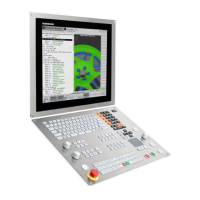37
Recessing
In this area, as well, the TNC 640
distinguishes itself with ample flexibility
and functionality. Simple recessing
operations in longitudinal and transverse
direction are just as possible as contour
recessing, in which the cycle is machined
along any desired contour. You can work
particularly effectively during recess
turning. Because infeed and cutting
alternate directly, air cuts are hardly
necessary. Here, too, the TNC considers
the technological constraints (width of
recessing tool from the tool table) and
executes the operations quickly and
reliably.
Thread machining
Simple and expanded cycles are available
for longitudinal and transverse machining of
cylindrical or tapered threads. You can use
cycle parameters to define the manner in
which the thread is produced. This enables
you to machine a wide variety of materials.
Blank form update
Another highlight of the TNC 640 is the
blank form update feature. If you define the
workpiece blank at the beginning of your
program, the control then computes the
new blank for each following step. The
machining cycles always adapt to the
current workpiece blank. The blank for
update feature helps you to avoid air cuts
and optimize approach paths.
Orientation of the turning tool
On milling/turning machines it can be
necessary to incline the tool during turning
or change the side from which the part is
to be machined. With the aid of a cycle,
the TNC can change the tool's angle of
incidence or use an outside turning tool as
an inside tool without having to adjust the
tool tip and/or the angle of orientation on
the tool table.
Eccentric turning (option)
With the eccentric turning function you can
perform turning operations even when the
tool axis, due to the setup situation, is not
aligned with the axis of rotation. During
machining, the TNC 640 compensates any
eccentricity with opposing movements of
the linear axis coupled with the rotating
spindle.

